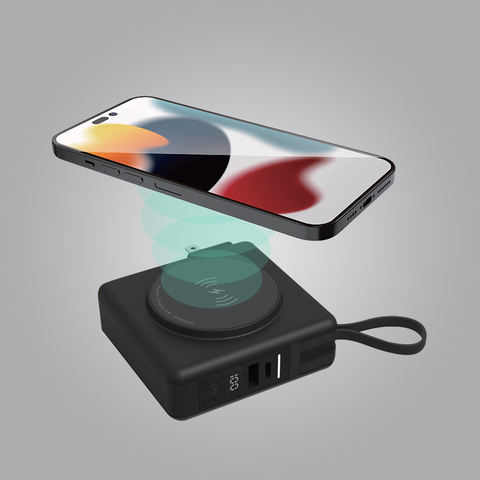
Introduction:
In a world where we rely on electronic devices for almost every aspect of daily life, having a reliable source of power is essential. Power banks have become an indispensable tool for keeping our devices charged throughout the day, whether we are commuting, traveling, or simply running errands.
One of the most important factors in choosing the right power bank for daily use is its capacity, measured in milliampere-hours (mAh). But how many mAh is truly necessary for everyday activities? This article will explore the ideal power bank capacity for different users and provide guidelines to help businesses and consumers make the best choice.
What mAh Power Bank Is Best for Daily Use?
For typical daily use, a power bank with a capacity between 10,000 mAh and 20,000 mAh is often the most suitable. This range provides enough power to charge most smartphones 2-5 times, depending on the device, while remaining portable enough for everyday carrying. For users with more demanding devices, such as tablets or laptops, or those who need multiple charges throughout the day, a power bank closer to 20,000 mAh may be more appropriate.
What is mAh and Why Is It Important?
The term “mAh” stands for milliampere-hour, a measurement of the electric charge that a battery can store. In simple terms, it indicates how much energy a power bank can hold and, subsequently, how many times it can charge your devices before it needs to be recharged itself.
- The higher the mAh, the more charge the power bank can store, which means it can recharge devices more times before it runs out of power.
- A lower mAh power bank will be lighter and more portable but may not offer enough capacity for multiple charges, especially for power-hungry devices.
For wholesalers and B2B customers, understanding mAh is crucial for determining the most suitable power bank capacity to offer to different customer segments.
The Ideal mAh for Different Types of Users
Choosing the right mAh capacity depends heavily on the user’s daily needs and the type of devices they use. Below are some common user profiles and the ideal power bank capacity for each:
- Casual Smartphone Users:
- Ideal Capacity: 5,000 mAh to 10,000 mAh
- These users primarily need to recharge their smartphones once or twice during the day. A power bank with 5,000 to 10,000 mAh is portable and sufficient for a full charge or two for most modern smartphones.
- Heavy Smartphone and Tablet Users:
- Ideal Capacity: 10,000 mAh to 20,000 mAh
- For users who frequently use their devices for streaming, gaming, or work, a higher capacity power bank is necessary. A 10,000 to 20,000 mAh power bank can provide multiple charges for smartphones and at least one full charge for a tablet.
- Laptop Users:
- Ideal Capacity: 20,000 mAh or more
- Laptops consume much more power than smartphones and tablets. A power bank with 20,000 mAh or more is recommended for users who need to recharge their laptops on the go. Some high-end power banks designed for laptops may even go up to 30,000 mAh.
For brands and wholesalers, offering a range of power bank capacities tailored to different user needs can help attract a broader customer base.
Factors Influencing the Choice of mAh Capacity
When deciding on the most suitable power bank capacity for daily use, several factors should be considered:
- Device Power Consumption:
- Different devices have different power requirements. Smartphones, for example, typically require 2,000 to 3,500 mAh for a full charge, while tablets may require 7,000 mAh or more.
- Usage Frequency:
- Users who are frequently on their phones or other devices throughout the day will require a higher-capacity power bank than those who use their devices only occasionally.
- Portability vs. Capacity:
- Larger capacity power banks, while more powerful, tend to be heavier and bulkier. Users who prioritize portability may prefer a smaller power bank, even if it means fewer charges.
- Charging Speed:
- Some power banks offer fast charging technology, which can charge devices more quickly but may also drain the power bank faster.
For B2B customers, understanding these factors helps in offering products that cater to a variety of customer preferences, from those looking for sleek, portable options to those needing high-capacity models for extended use.
How to Calculate Your Daily Power Needs
To determine the most suitable mAh for daily use, users can estimate their daily power needs by considering the following:
- Determine the mAh capacity of your device battery:
- Most smartphones have batteries ranging from 2,500 to 4,000 mAh, while tablets and laptops may have much larger batteries.
- Estimate the number of charges you need per day:
- For instance, if you need to charge your 3,000 mAh smartphone twice a day, you’ll need at least a 6,000 mAh power bank.
- Factor in Efficiency Loss:
- Power banks are not 100% efficient, meaning you won’t get the full mAh capacity. Generally, you can expect about 70-80% of the listed capacity due to energy loss during the charging process. So, for a 10,000 mAh power bank, you might only get about 7,000 to 8,000 mAh of usable power.
By understanding how to calculate daily power needs, businesses can better assist their customers in choosing the right power bank capacity.
The Role of Device Type and Usage Frequency
The type of devices you use and how often you use them will directly impact the mAh capacity you need in a power bank. For example:
- Smartphones: Frequent texting, calls, social media, and video streaming can quickly drain a smartphone battery. For heavy smartphone users, a 10,000 mAh power bank can easily cover multiple charges throughout the day.
- Tablets: With their larger screens and more intensive applications, tablets require more power to charge. A 15,000 to 20,000 mAh power bank is ideal for users who rely heavily on tablets for work or entertainment.
- Laptops: For professionals who need to power their laptops on the go, a high-capacity power bank (20,000 mAh or more) is essential to provide at least one full charge, depending on the laptop model.
Understanding these variations allows businesses to offer tailored solutions that meet the specific needs of different customer groups.
Portability vs. Capacity: Striking the Right Balance
When selecting a power bank for daily use, users often face a trade-off between portability and capacity. Larger power banks can charge more devices or provide more charges but are bulkier and heavier. On the other hand, smaller power banks are more portable but offer less charging power.
For B2B clients, it’s important to offer a variety of power banks that cater to both ends of the spectrum. Some users may prioritize portability and prefer a sleek, lightweight design, while others may be willing to sacrifice portability for a higher capacity that ensures they never run out of power.
Summary:
In conclusion, the most suitable mAh power bank for daily use typically ranges between 10,000 mAh and 20,000 mAh, depending on the user’s specific needs. For casual smartphone users, a 10,000 mAh power bank will provide ample capacity for a full day’s usage, while heavy users and those who use multiple devices may prefer a power bank closer to 20,000 mAh.
By considering factors such as device type, usage frequency, and portability, businesses and consumers can make informed decisions about the best power bank capacity for their needs.
For wholesalers, brands, and B2B customers, offering a range of power bank capacities will cater to the diverse needs of the market, ensuring that customers find the perfect solution for their daily power requirements.







